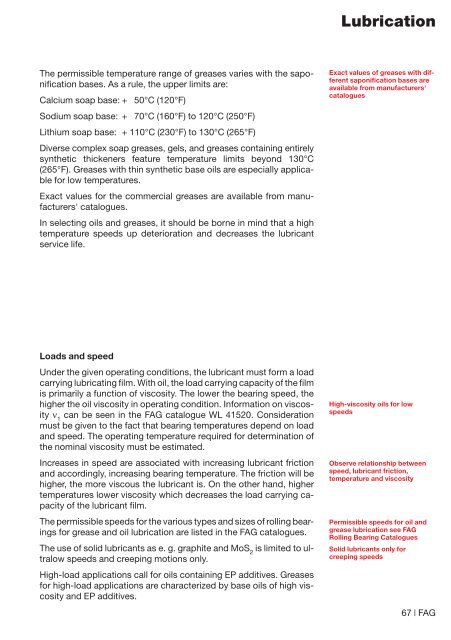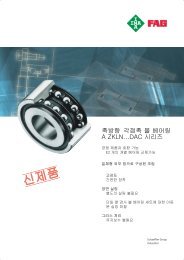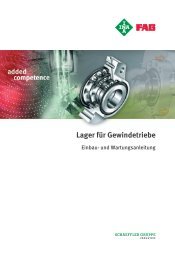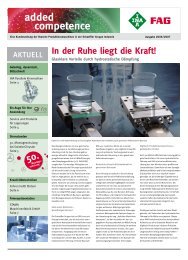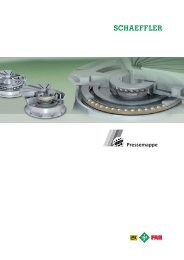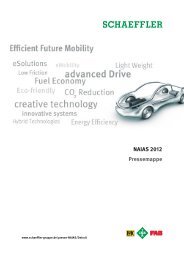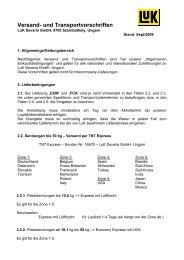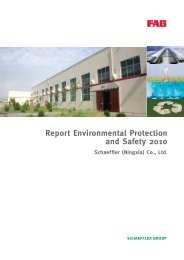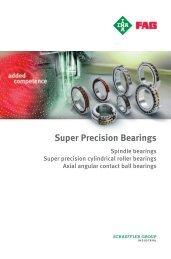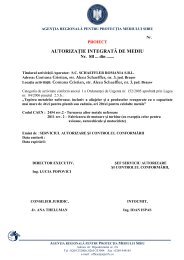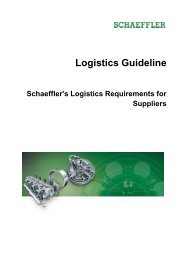Mounting and Dismounting of Rolling Bearings - Schaeffler Group
Mounting and Dismounting of Rolling Bearings - Schaeffler Group
Mounting and Dismounting of Rolling Bearings - Schaeffler Group
You also want an ePaper? Increase the reach of your titles
YUMPU automatically turns print PDFs into web optimized ePapers that Google loves.
The permissible temperature range <strong>of</strong> greases varies with the sapon<br />
ification bases. As a rule, the upper limits are:<br />
Calcium soap base: + 50°C (120°F)<br />
Sodium soap base: + 70°C (160°F) to 120°C (250°F)<br />
Lithium soap base: + 110°C (230°F) to 130°C (265°F)<br />
Diverse complex soap greases, gels, <strong>and</strong> greases containing entirely<br />
synthetic thickeners feature temperature limits beyond 130°C<br />
(265°F). Greases with thin synthetic base oils are especially applicable<br />
for low temperatures.<br />
Exact values for the commercial greases are available from manufacturers'<br />
catalogues.<br />
In selecting oils <strong>and</strong> greases, it should be borne in mind that a high<br />
temperature speeds up deterioration <strong>and</strong> decreases the lubricant<br />
service life.<br />
Loads <strong>and</strong> speed<br />
Under the given operating conditions, the lubricant must form a load<br />
carrying lubricating film. With oil, the load carrying capacity <strong>of</strong> the film<br />
is primarily a function <strong>of</strong> viscosity. The lower the bearing speed, the<br />
higher the oil viscosity in operating condition. Information on viscos -<br />
ity ν1 can be seen in the FAG catalogue WL 41520. Consideration<br />
must be given to the fact that bearing temperatures depend on load<br />
<strong>and</strong> speed. The operating temperature required for determination <strong>of</strong><br />
the nominal viscosity must be estimated.<br />
Increases in speed are associated with increasing lubricant friction<br />
<strong>and</strong> accordingly, increasing bearing temperature. The friction will be<br />
higher, the more viscous the lubricant is. On the other h<strong>and</strong>, higher<br />
temperatures lower viscosity which decreases the load carrying capacity<br />
<strong>of</strong> the lubricant film.<br />
The permissible speeds for the various types <strong>and</strong> sizes <strong>of</strong> rolling bearings<br />
for grease <strong>and</strong> oil lubrication are listed in the FAG catalogues.<br />
The use <strong>of</strong> solid lubricants as e. g. graphite <strong>and</strong> MoS2 is limited to ultralow<br />
speeds <strong>and</strong> creeping motions only.<br />
High-load applications call for oils containing EP additives. Greases<br />
for high-load applications are characterized by base oils <strong>of</strong> high viscosity<br />
<strong>and</strong> EP additives.<br />
Lubrication<br />
Exact values <strong>of</strong> greases with different<br />
saponification bases are<br />
available from manufacturers'<br />
catalogues<br />
High-viscosity oils for low<br />
speeds<br />
Observe relationship between<br />
speed, lubricant friction,<br />
temper ature <strong>and</strong> viscosity<br />
Permissible speeds for oil <strong>and</strong><br />
grease lubrication see FAG<br />
<strong>Rolling</strong> Bearing Catalogues<br />
Solid lubricants only for<br />
creeping speeds<br />
67 | FAG


